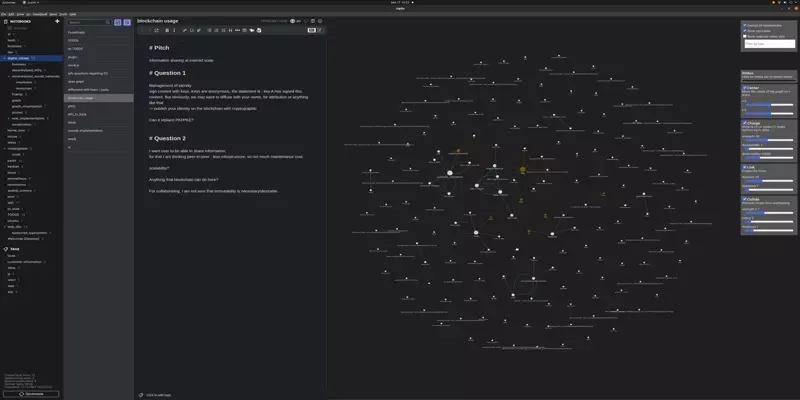Description
Notes as nodes. Explore your Joplin knowledge graph.
Additional Information
| Links: | |
|---|---|
| Maintainers: | agerardin |
| Version: | 1.1.0 |
| Minimum app version: | 2.2 |
| Downloads: This version: | 11759 |
| Last updated: | 2022-01-14T17:35:05Z |
Joplin Graph Plugin
This joplin plugin turns notes into nodes in a knowledge graph.

Links are built from tags and from cross-links between notes.
- The visualization can scale reasonably well to display up to several thousand nodes and links at the same time.
- Nodes and links can be filtered dynamically to explore data.
- The graph layout can be customized dynamically to help navigate large graphs.
- Support multiple links between notes.
Controls
CTRL+click or META+click on a node opens the related note in the editor.
SHIFT+click for multiple node selection.
Layout options
The layout is based on as set of d3 forces that can be enabled/disabled. Many options are supported in order to tune the layout depending on the specific data.
Filters
Filters are essential to remove noise and for performance reasons.
Several filters are implemented and can be composed as conjunct terms (AND).
- view can be focused on selected nodes.
- tags can be filtered and several tags can be selected as disjoint filtering terms (OR).
- nodes representing tags can be displayed or not.
- multiple relationships between two nodes can be aggregated as one.
Settings
plugin settings help tune the graph rendering.
In particular, simulation settings COOLDOWN_TIME, COOLDOWN_TICKS & WARMUP_TICKS can help rendering larger graphs.
Label size are also customizable.
Similar projects and related plugins
This plugin works best in combination with other plugins that helps manage links and backlinks, provide links preview or facilate creating notes from existing notes.
The graph interactions have been inspired by the foam vscode extension : https://foambubble.github.io/foam/.
You may also want to look at another graph plugin for Joplin https://github.com/treymo/joplin-link-graph which
also provide graph visualization.
Development
Project Structure
src/core a generic graph model
src/joplin joplin specific code
src/common definitions shared by the core and joplin component
src/ui ui components
index.ts plugin bootstrap
Building the plugin
The plugin is built using Webpack, which creates the compiled code in /dist. A JPL archive will also be created at the root, which can use to distribute the plugin.
To build the plugin, simply run npm run dist.
Development workflow
npm run test can be used to generate sourceMaps useful for debugging.
npm run test-ui will pop up the ui in the browser using webpack dev-server which is useful when working on the ui instead of rebuilding the plugin each time.
Note that this requires webpack-cli@4 while building for joplin requires webpack-cli@3.
So for now we need to get back and forth : npm install webpack-cli@4 or npm install webpack-cli@3 when developing the ui and testing integration.
npm run test will run a jest test suite.
Dependencies
This project is written Typescript and React. Main dependencies:
- d3:
https://github.com/d3/d3 - d3 library:
https://github.com/vasturiano/force-graph. - react component for tag selection:
https://github.com/react-tags/react-tags
The layout controls have been adapted from :
https://bl.ocks.org/steveharoz/8c3e2524079a8c440df60c1ab72b5d03
Updating the plugin framework
To update the plugin framework, run npm run update.
A few changes have been made to the stock webpack.config.js so caution is required when trying to update the plugin framework.
Notes
Plugin/UI Communication
Short of a mechanism for a two-way async communication between the ui and the plugin, plugin events are recorded in a queue.
Whenever the ui is ready to process a new events, it notifies the plugin, which will poll events from the queues at the rate of a consumption of the ui until the queue is empty.
Style
This plugin is not yet adapting to Joplin Themes. Dark Themes work best.
Licensing
MIT License.